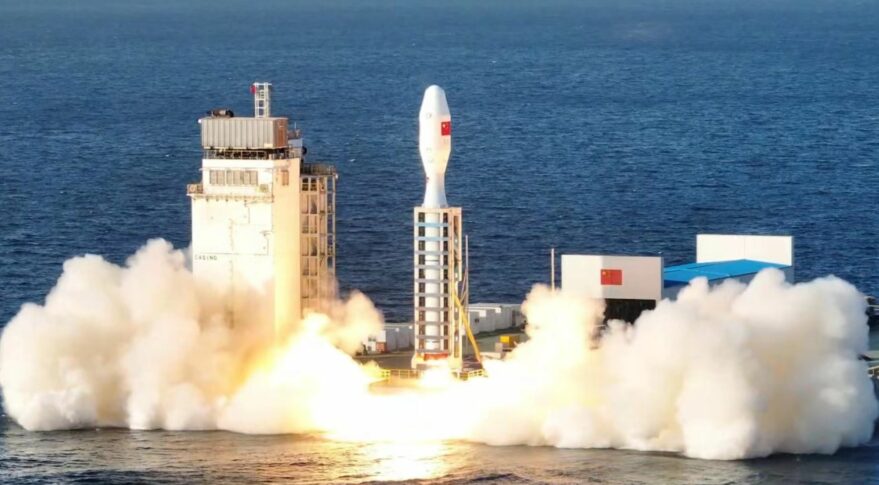
China launches 14 satellites with new solid rocket from mobile sea platform (Image Credit: Space News)
HELSINKI — China launched its new Jielong-3 rocket from a mobile sea platform in the Yellow Sea Friday, successfully sending 14 satellites into orbit.
The Jielong-3 (“Smart Dragon-3”) lifted off at 1:35 a.m. Eastern (0635 UTC) Dec. 9, from the Tai Rui modified barge off in the Yellow Sea.
The mission carried eight satellites developed by commercial remote sensing firm Changguang Satellite Technology, designated Jilin-1 Gaofen 03D 44-50 remote sensing satellite and the Jilin-1 Pingtai 01A01 satellites. The latter is a new satellite platform adaptable to remote sensing, communications or navigation requirements.
Also aboard the launch were the Fengtai Shaonian-2 (CAS-5A) satellite, Head-2H, the Golden Bauhinia-1 05 and 06 satellites, Tianqi-07, and Torch-1, a first life science experiment satellite for private firm Rocket Pi.
The four-stage rocket can carry 1,500 kilograms of payload into a 500-kilometer Sun-synchronous orbit (SSO) and was developed by China Rocket Co. Ltd.
Jielong-3 has close similarities in terms of lift capacity, length and diameter (2.65 meters), payload fairing (3.35 meters) and mass at liftoff with the ZK-1A rocket developed and recently launched by a group under the Chinese Academy of Sciences.
China Rocket is a commercial spinoff from CALT, a main launch vehicle manufacturing arm under the state-owned China Aerospace Science and Technology Corporation (CASC), China’s main space contractor.
[🔴China’s 58th launch in 2022] At UTC 06:35 Dec 9, 14 satellites including Jilin1-03D-(47-50) remote sensing satellites were successfully launched by Jielong-3/捷龙-3/SmartDragon-3 Y1 rocket at Yellow Sea. It’s the solid-fuel rocket’s maiden flight. HD: https://t.co/qZGEQd0nUh pic.twitter.com/aFyYCuHxl3
— CNSA Watcher (@CNSAWatcher) December 9, 2022
Jiang Jie, a senior CALT rocket designer, said in March 2021 that the rocket would aim to bring the price of sending one kilogram to orbit down to $10,000, when producing 20 rockets per year.
It is the second launch for China Rocket, following the sole launch of Jielong-1 back in 2019. The planned step of developing and launching the Jielong-2 rocket—very similar in capabilities to the extant Long March 11 solid rocket—has apparently been skipped.
China Rocket stated Friday that it is working on a Jielong-4 rocket which would utilize a 500-ton-thrust solid engine. Though not explicitly stated, such an engine was test-fired by CASC in 2021.
China has launched Long March 11 rockets from the Yellow Sea previously. Those launches were “cold” launches, with the rocket expelled from its container with a separate gas system. The Jielong-3 was China’s first sea hot launch, propelling itself from its launch cell with its own engines. The launch structure extends out from the vessel over the water, allowing the dissipation and suppression of the rocket’s exhaust.
The mission highlights two separate developments. First, China is committed to developing a range of solid rockets to boost its overall space capabilities.
“Overall, from a strategic point of view, mastering such a new capability gives China flexibility and redundancy, demonstrates technological prowess to the outside world and create important synergies for other, non-space objectives,” Tomas Hrozensky, a researcher at the European Space Policy Institute (ESPI), told SpaceNews earlier this year.
Second is the growing role of sea launch capabilities. Preparations for launch were made at facilities near Haiyang in the eastern coastal province of Shandong, which provide China with another option for accessing space.
The Haiyang spaceport provides both greater flexibility and reduces pressure on China’s main spaceports. The project is also seeking to attract a range of space sector firms to foster a space industrial chain.
Private firms including Orienspace with its Gravity series rockets and Galactic Energy with the Ceres-1 solid rocket are planning sea launches. This is in addition to activities related to China Rocket and the state-owned China Academy of Launch Vehicle Technology (CALT), which is apparently working on an adapted Long March 8 launcher for sea launches.
China Rocket says it is working on new phases on construction of assembly and testing facilities in Shandong and aims to reach an annual production capacity of 20 rockets by the end of 2023.
The launch was China’s 58th of 2022, already surpassing the country’s record set in 2021.








